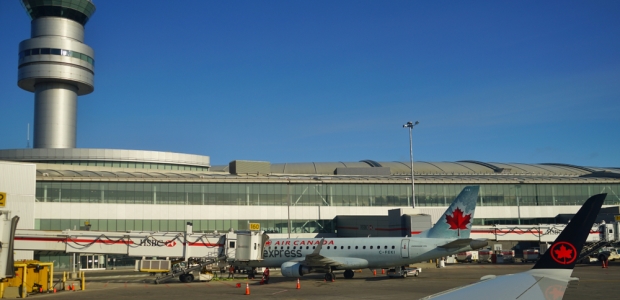
Agency Recommends Revamping Taxiways at Canada's Busiest Airport
The board's investigation found that all 27 runway incursions at Toronto/Lester B. Pearson International Airport between June 2012 and November 2017 happened on the inner runway after the flight crews involved had landed on the outer runway and were taxiing on a rapid-exit taxiway between the two runways. It found that several characteristics of the rapid exits in this area are different from almost every other major airport in North America.
The Transportation Safety Board of Canada has made four recommendations for changes at Toronto/Lester B. Pearson International Airport after investigating 27 runway incursions that occurred between two closely spaced parallel runways there between June 2012 and November 2017. One of the recommendations in the agency's Jan. 31 report is that the Greater Toronto Airports Authority revise the taxiway layout in an area of the airport known as the "south complex," in order to reduce the risk of incursions between parallel runways.
"Pearson International airport traffic is tightly controlled and monitored, and all 27 incursions examined involved flight crews who understood they needed to stop and that they were approaching an active runway," said Kathy Fox, chair of the TSB. "Despite all the visual cues, including lights, signage, and paint markings, professional crews were not stopping in time as required, thereby risking a collision with another aircraft on the other runway."
The board's investigation found that all of the incursions happened on the inner runway after the flight crews involved had landed on the outer runway and were taxiing on a rapid-exit taxiway between the two runways. If found that several characteristics of the rapid exits in this area, which is known locally as the south complex, are different from almost every other major airport in North America. The exits lead directly to the inner parallel runway, the hold lines are located immediately following a 65-degree curve, and they are farther away from the protected runway than is commonly seen elsewhere. These uncommon features mean the hold lines are not where crews are expecting to see them.
The investigation also determined that, although flight crews were aware of the increased risk for runway incursions in the area because they are designated as "hot spots" on the airport charts, that guidance did not bring crews' attention to specific strategies to mitigate the risk of incursions. Instead, crews followed their standard operating procedures and initiated their post-landing actions immediately after exiting the runway, taking their attention away from other more critical tasks, such as identifying the hold lines.
The board's four recommendations to make the runways safer are:
- NAV CANADA should amend its guidance so that safety-critical transmissions are more compelling to flight crews in order for crews to take the safest course of action.
- Both Transport Canada and the U.S. Federal Aviation Administration should work with operators to amend standard operating procedures so that crews only commence post-landing checks after a landing aircraft has cleared all active runways.
- The Greater Toronto Airports Authority should make physical changes to the taxiway layout at Pearson International's south complex to address the risk of incursions between the parallel runways.
"Fixing these complex issues won't be easy, which means all those involved must work together," Fox said. "Because, clearly, more needs to be done—so that all flight crews see the cues and react as required."
The Greater Toronto Airports Authority released a statement Jan. 31 saying it is reviewing the board's recommendations. "We welcome the findings and we have fully participated in the review," the statement said. "Safety is our top priority, and we will continue to make improvements that enable continued safe operations for the surrounding communities and the nearly 50 million people who use Toronto Pearson on an annual basis. Since 2013, the GTAA has continued to address incidents at Toronto Pearson by working with the air carriers, particularly those regional U.S. carriers that experience a higher number of the incidents. In addition to specific enhancements to our runways and taxiways, new lighting systems, and mandatory LED backlit signage, we have also provided up-to-date safety information and educational outreach to these carriers about our operations. We remain vigilant with regard to industry trends and developments in technology that can help us meet our commitment to safety."